Gender and Power: An Analysis of Australian Workplace Dynamics
VerifiedAdded on 2023/06/05
|13
|3420
|150
Essay
AI Summary
This essay examines gender dynamics and power imbalances within Australian workplaces, focusing on issues such as gender discrimination, the gender pay gap, and female boss harassment. It highlights the persistent under-representation of women in senior management roles and male-dominated sectors, despite Australia's commitment to international human rights treaties like CEDAWA. The essay also addresses the factors contributing to the gender pay gap, including societal perceptions, job allocation, and the impact of family responsibilities on women's career progression. Furthermore, it explores the prevalence of sexual harassment in creative industries, linking it to job competition, workplace culture, and gender-related power dynamics. The essay concludes by acknowledging that while sex discrimination is a significant factor, other elements, such as individual preferences and work-life balance choices, also contribute to the observed disparities.
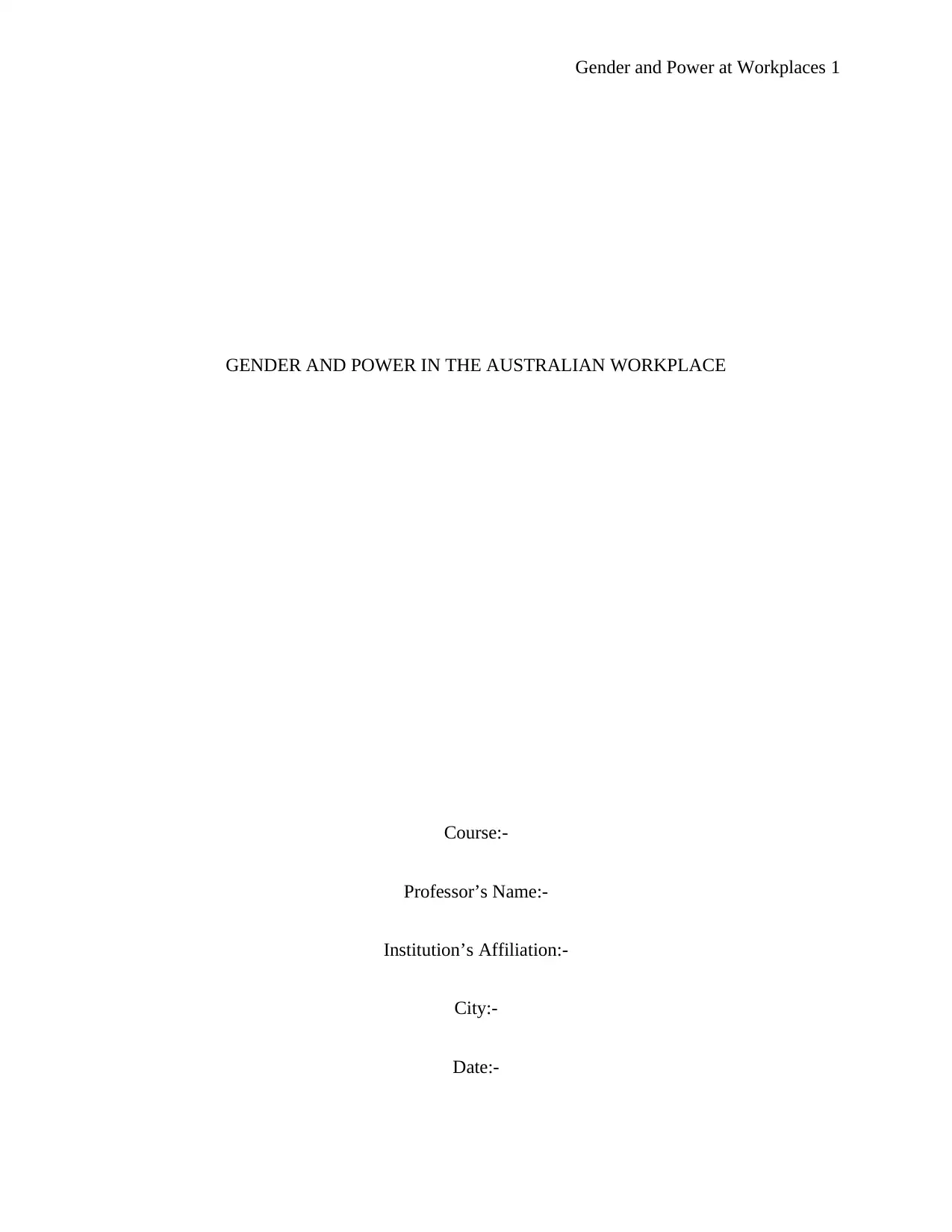
Gender and Power at Workplaces 1
GENDER AND POWER IN THE AUSTRALIAN WORKPLACE
Course:-
Professor’s Name:-
Institution’s Affiliation:-
City:-
Date:-
GENDER AND POWER IN THE AUSTRALIAN WORKPLACE
Course:-
Professor’s Name:-
Institution’s Affiliation:-
City:-
Date:-
Paraphrase This Document
Need a fresh take? Get an instant paraphrase of this document with our AI Paraphraser
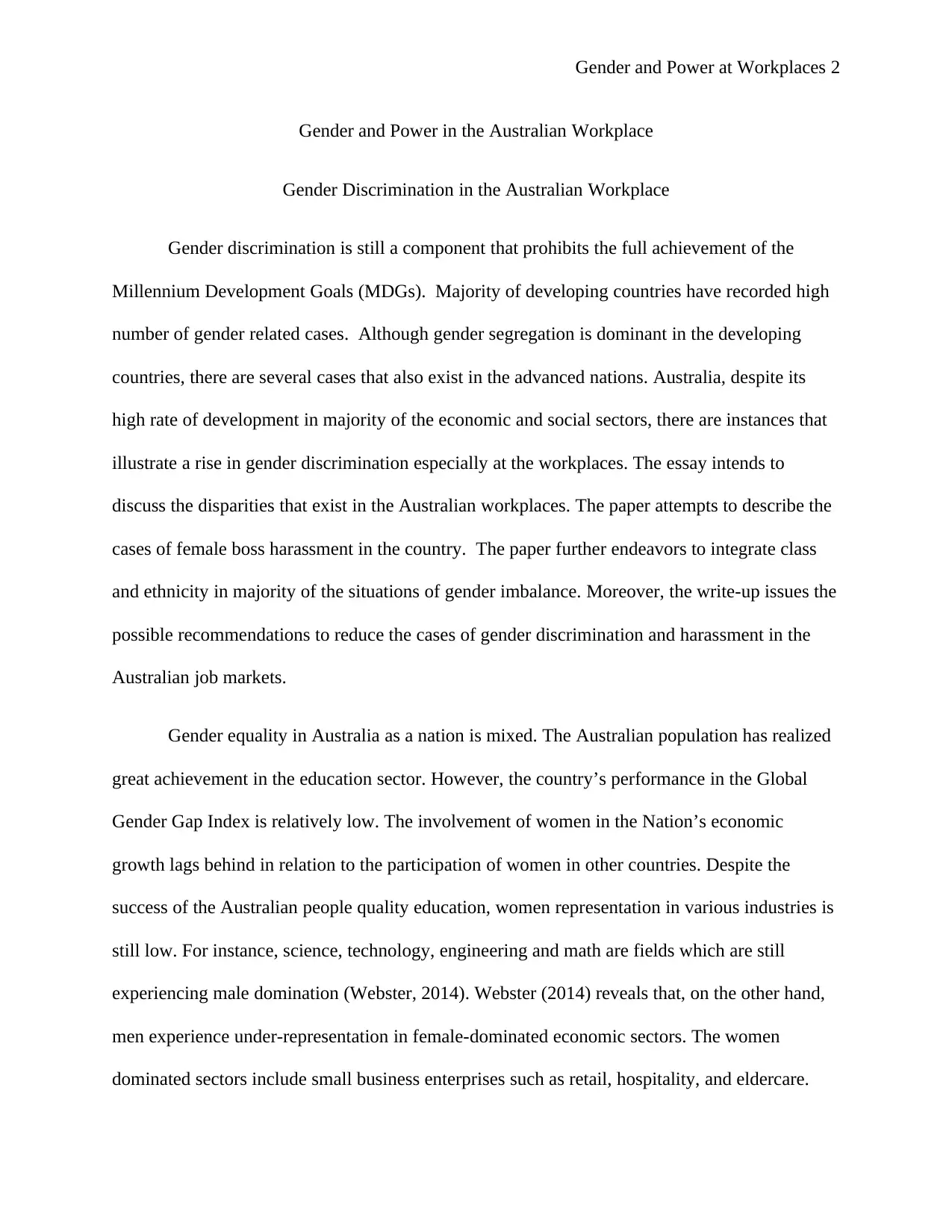
Gender and Power at Workplaces 2
Gender and Power in the Australian Workplace
Gender Discrimination in the Australian Workplace
Gender discrimination is still a component that prohibits the full achievement of the
Millennium Development Goals (MDGs). Majority of developing countries have recorded high
number of gender related cases. Although gender segregation is dominant in the developing
countries, there are several cases that also exist in the advanced nations. Australia, despite its
high rate of development in majority of the economic and social sectors, there are instances that
illustrate a rise in gender discrimination especially at the workplaces. The essay intends to
discuss the disparities that exist in the Australian workplaces. The paper attempts to describe the
cases of female boss harassment in the country. The paper further endeavors to integrate class
and ethnicity in majority of the situations of gender imbalance. Moreover, the write-up issues the
possible recommendations to reduce the cases of gender discrimination and harassment in the
Australian job markets.
Gender equality in Australia as a nation is mixed. The Australian population has realized
great achievement in the education sector. However, the country’s performance in the Global
Gender Gap Index is relatively low. The involvement of women in the Nation’s economic
growth lags behind in relation to the participation of women in other countries. Despite the
success of the Australian people quality education, women representation in various industries is
still low. For instance, science, technology, engineering and math are fields which are still
experiencing male domination (Webster, 2014). Webster (2014) reveals that, on the other hand,
men experience under-representation in female-dominated economic sectors. The women
dominated sectors include small business enterprises such as retail, hospitality, and eldercare.
Gender and Power in the Australian Workplace
Gender Discrimination in the Australian Workplace
Gender discrimination is still a component that prohibits the full achievement of the
Millennium Development Goals (MDGs). Majority of developing countries have recorded high
number of gender related cases. Although gender segregation is dominant in the developing
countries, there are several cases that also exist in the advanced nations. Australia, despite its
high rate of development in majority of the economic and social sectors, there are instances that
illustrate a rise in gender discrimination especially at the workplaces. The essay intends to
discuss the disparities that exist in the Australian workplaces. The paper attempts to describe the
cases of female boss harassment in the country. The paper further endeavors to integrate class
and ethnicity in majority of the situations of gender imbalance. Moreover, the write-up issues the
possible recommendations to reduce the cases of gender discrimination and harassment in the
Australian job markets.
Gender equality in Australia as a nation is mixed. The Australian population has realized
great achievement in the education sector. However, the country’s performance in the Global
Gender Gap Index is relatively low. The involvement of women in the Nation’s economic
growth lags behind in relation to the participation of women in other countries. Despite the
success of the Australian people quality education, women representation in various industries is
still low. For instance, science, technology, engineering and math are fields which are still
experiencing male domination (Webster, 2014). Webster (2014) reveals that, on the other hand,
men experience under-representation in female-dominated economic sectors. The women
dominated sectors include small business enterprises such as retail, hospitality, and eldercare.
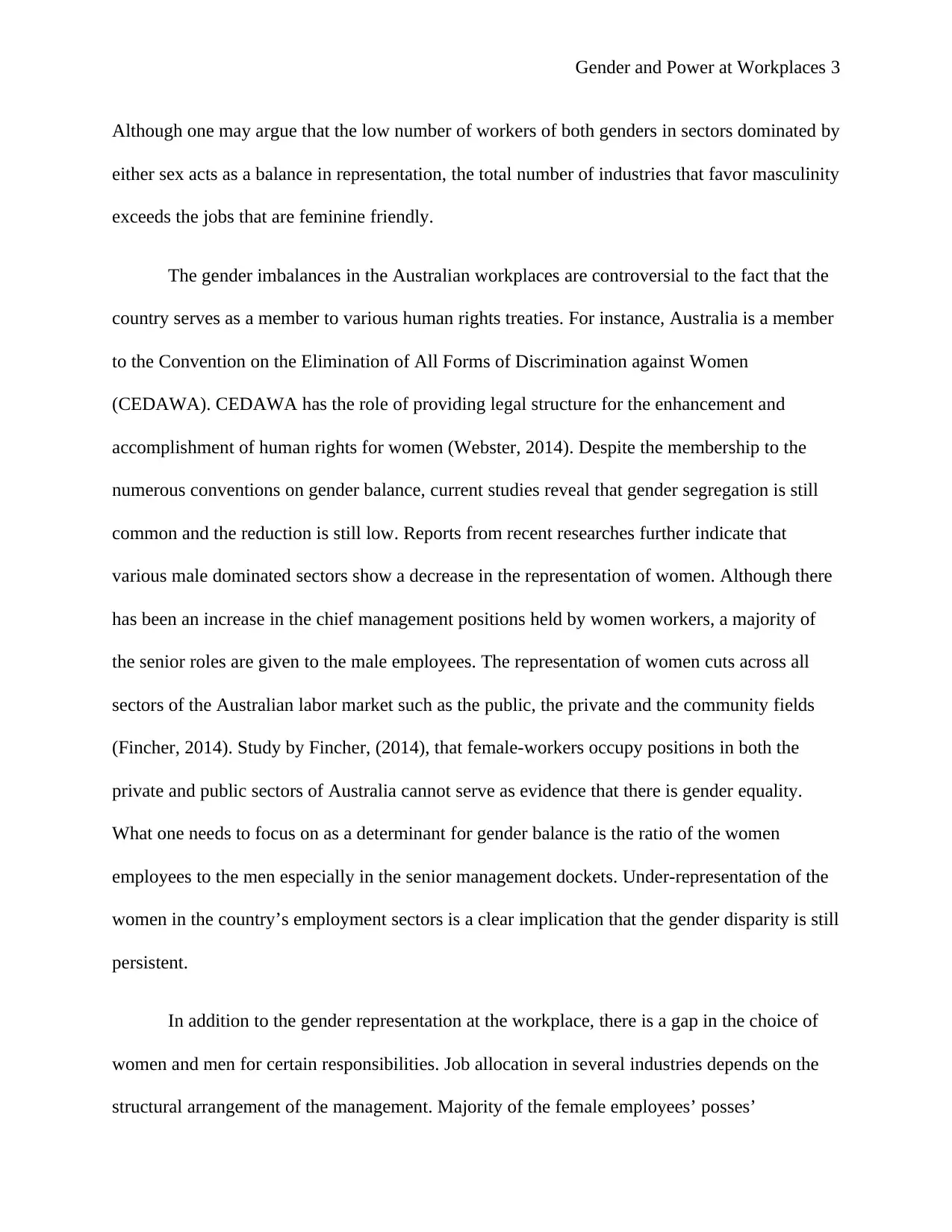
Gender and Power at Workplaces 3
Although one may argue that the low number of workers of both genders in sectors dominated by
either sex acts as a balance in representation, the total number of industries that favor masculinity
exceeds the jobs that are feminine friendly.
The gender imbalances in the Australian workplaces are controversial to the fact that the
country serves as a member to various human rights treaties. For instance, Australia is a member
to the Convention on the Elimination of All Forms of Discrimination against Women
(CEDAWA). CEDAWA has the role of providing legal structure for the enhancement and
accomplishment of human rights for women (Webster, 2014). Despite the membership to the
numerous conventions on gender balance, current studies reveal that gender segregation is still
common and the reduction is still low. Reports from recent researches further indicate that
various male dominated sectors show a decrease in the representation of women. Although there
has been an increase in the chief management positions held by women workers, a majority of
the senior roles are given to the male employees. The representation of women cuts across all
sectors of the Australian labor market such as the public, the private and the community fields
(Fincher, 2014). Study by Fincher, (2014), that female-workers occupy positions in both the
private and public sectors of Australia cannot serve as evidence that there is gender equality.
What one needs to focus on as a determinant for gender balance is the ratio of the women
employees to the men especially in the senior management dockets. Under-representation of the
women in the country’s employment sectors is a clear implication that the gender disparity is still
persistent.
In addition to the gender representation at the workplace, there is a gap in the choice of
women and men for certain responsibilities. Job allocation in several industries depends on the
structural arrangement of the management. Majority of the female employees’ posses’
Although one may argue that the low number of workers of both genders in sectors dominated by
either sex acts as a balance in representation, the total number of industries that favor masculinity
exceeds the jobs that are feminine friendly.
The gender imbalances in the Australian workplaces are controversial to the fact that the
country serves as a member to various human rights treaties. For instance, Australia is a member
to the Convention on the Elimination of All Forms of Discrimination against Women
(CEDAWA). CEDAWA has the role of providing legal structure for the enhancement and
accomplishment of human rights for women (Webster, 2014). Despite the membership to the
numerous conventions on gender balance, current studies reveal that gender segregation is still
common and the reduction is still low. Reports from recent researches further indicate that
various male dominated sectors show a decrease in the representation of women. Although there
has been an increase in the chief management positions held by women workers, a majority of
the senior roles are given to the male employees. The representation of women cuts across all
sectors of the Australian labor market such as the public, the private and the community fields
(Fincher, 2014). Study by Fincher, (2014), that female-workers occupy positions in both the
private and public sectors of Australia cannot serve as evidence that there is gender equality.
What one needs to focus on as a determinant for gender balance is the ratio of the women
employees to the men especially in the senior management dockets. Under-representation of the
women in the country’s employment sectors is a clear implication that the gender disparity is still
persistent.
In addition to the gender representation at the workplace, there is a gap in the choice of
women and men for certain responsibilities. Job allocation in several industries depends on the
structural arrangement of the management. Majority of the female employees’ posses’
⊘ This is a preview!⊘
Do you want full access?
Subscribe today to unlock all pages.

Trusted by 1+ million students worldwide
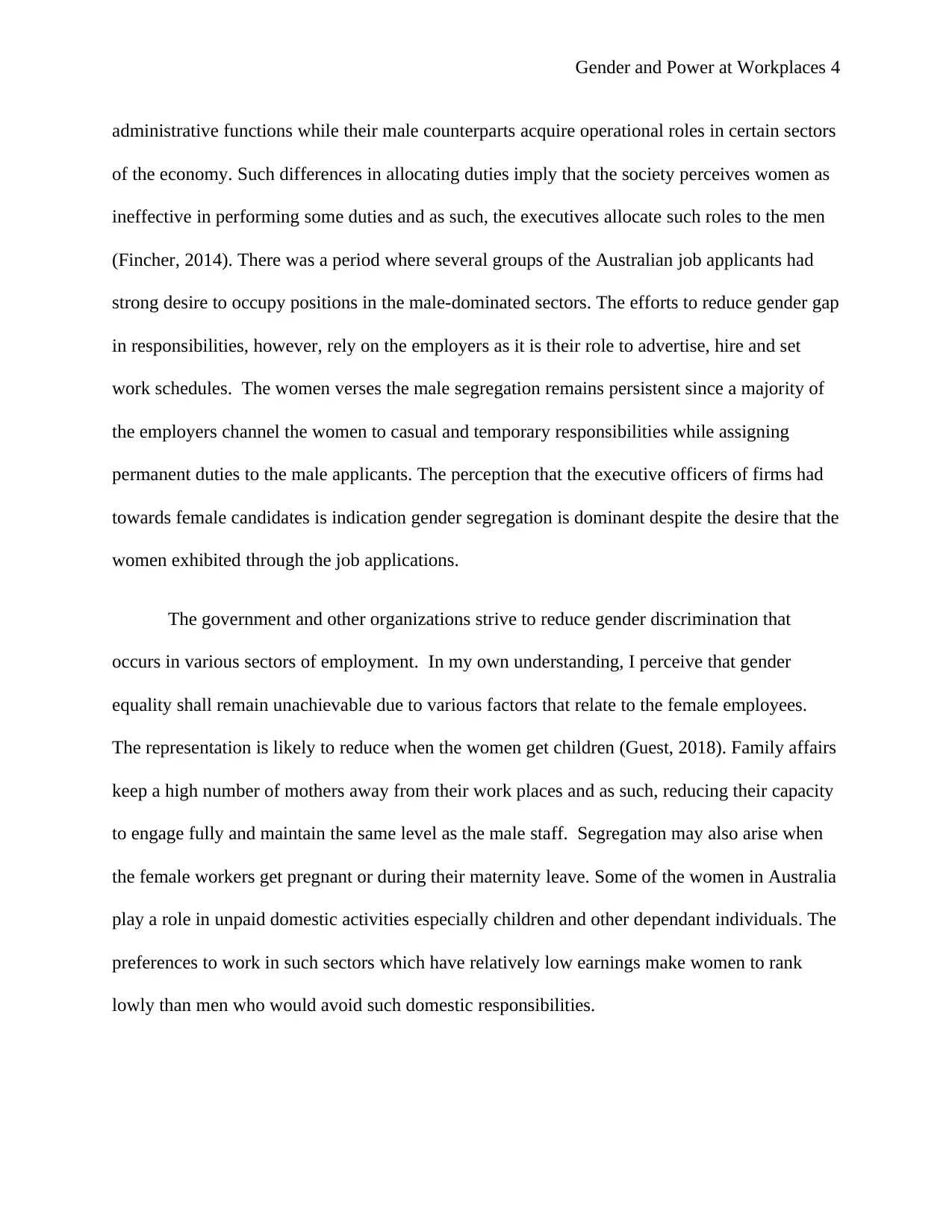
Gender and Power at Workplaces 4
administrative functions while their male counterparts acquire operational roles in certain sectors
of the economy. Such differences in allocating duties imply that the society perceives women as
ineffective in performing some duties and as such, the executives allocate such roles to the men
(Fincher, 2014). There was a period where several groups of the Australian job applicants had
strong desire to occupy positions in the male-dominated sectors. The efforts to reduce gender gap
in responsibilities, however, rely on the employers as it is their role to advertise, hire and set
work schedules. The women verses the male segregation remains persistent since a majority of
the employers channel the women to casual and temporary responsibilities while assigning
permanent duties to the male applicants. The perception that the executive officers of firms had
towards female candidates is indication gender segregation is dominant despite the desire that the
women exhibited through the job applications.
The government and other organizations strive to reduce gender discrimination that
occurs in various sectors of employment. In my own understanding, I perceive that gender
equality shall remain unachievable due to various factors that relate to the female employees.
The representation is likely to reduce when the women get children (Guest, 2018). Family affairs
keep a high number of mothers away from their work places and as such, reducing their capacity
to engage fully and maintain the same level as the male staff. Segregation may also arise when
the female workers get pregnant or during their maternity leave. Some of the women in Australia
play a role in unpaid domestic activities especially children and other dependant individuals. The
preferences to work in such sectors which have relatively low earnings make women to rank
lowly than men who would avoid such domestic responsibilities.
administrative functions while their male counterparts acquire operational roles in certain sectors
of the economy. Such differences in allocating duties imply that the society perceives women as
ineffective in performing some duties and as such, the executives allocate such roles to the men
(Fincher, 2014). There was a period where several groups of the Australian job applicants had
strong desire to occupy positions in the male-dominated sectors. The efforts to reduce gender gap
in responsibilities, however, rely on the employers as it is their role to advertise, hire and set
work schedules. The women verses the male segregation remains persistent since a majority of
the employers channel the women to casual and temporary responsibilities while assigning
permanent duties to the male applicants. The perception that the executive officers of firms had
towards female candidates is indication gender segregation is dominant despite the desire that the
women exhibited through the job applications.
The government and other organizations strive to reduce gender discrimination that
occurs in various sectors of employment. In my own understanding, I perceive that gender
equality shall remain unachievable due to various factors that relate to the female employees.
The representation is likely to reduce when the women get children (Guest, 2018). Family affairs
keep a high number of mothers away from their work places and as such, reducing their capacity
to engage fully and maintain the same level as the male staff. Segregation may also arise when
the female workers get pregnant or during their maternity leave. Some of the women in Australia
play a role in unpaid domestic activities especially children and other dependant individuals. The
preferences to work in such sectors which have relatively low earnings make women to rank
lowly than men who would avoid such domestic responsibilities.
Paraphrase This Document
Need a fresh take? Get an instant paraphrase of this document with our AI Paraphraser
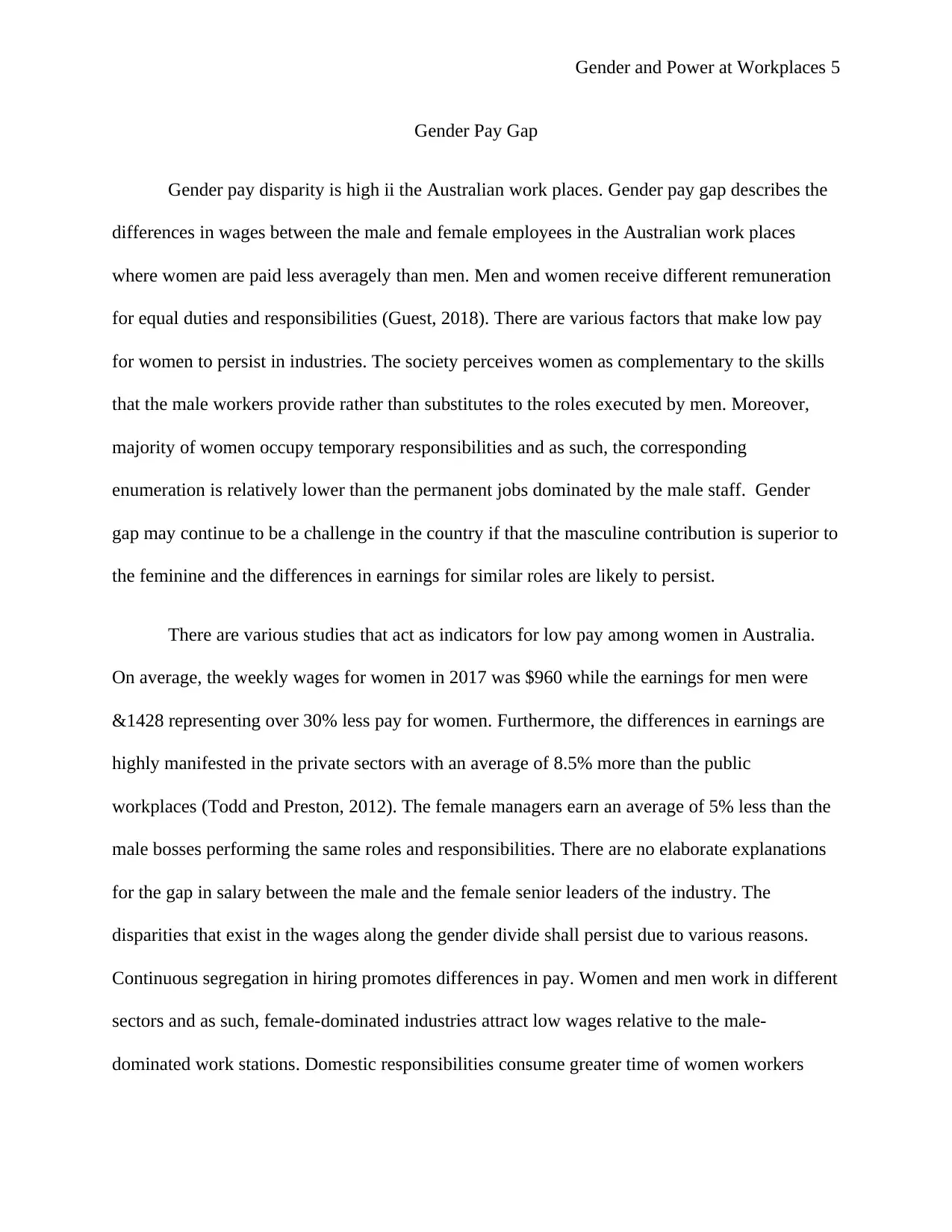
Gender and Power at Workplaces 5
Gender Pay Gap
Gender pay disparity is high ii the Australian work places. Gender pay gap describes the
differences in wages between the male and female employees in the Australian work places
where women are paid less averagely than men. Men and women receive different remuneration
for equal duties and responsibilities (Guest, 2018). There are various factors that make low pay
for women to persist in industries. The society perceives women as complementary to the skills
that the male workers provide rather than substitutes to the roles executed by men. Moreover,
majority of women occupy temporary responsibilities and as such, the corresponding
enumeration is relatively lower than the permanent jobs dominated by the male staff. Gender
gap may continue to be a challenge in the country if that the masculine contribution is superior to
the feminine and the differences in earnings for similar roles are likely to persist.
There are various studies that act as indicators for low pay among women in Australia.
On average, the weekly wages for women in 2017 was $960 while the earnings for men were
&1428 representing over 30% less pay for women. Furthermore, the differences in earnings are
highly manifested in the private sectors with an average of 8.5% more than the public
workplaces (Todd and Preston, 2012). The female managers earn an average of 5% less than the
male bosses performing the same roles and responsibilities. There are no elaborate explanations
for the gap in salary between the male and the female senior leaders of the industry. The
disparities that exist in the wages along the gender divide shall persist due to various reasons.
Continuous segregation in hiring promotes differences in pay. Women and men work in different
sectors and as such, female-dominated industries attract low wages relative to the male-
dominated work stations. Domestic responsibilities consume greater time of women workers
Gender Pay Gap
Gender pay disparity is high ii the Australian work places. Gender pay gap describes the
differences in wages between the male and female employees in the Australian work places
where women are paid less averagely than men. Men and women receive different remuneration
for equal duties and responsibilities (Guest, 2018). There are various factors that make low pay
for women to persist in industries. The society perceives women as complementary to the skills
that the male workers provide rather than substitutes to the roles executed by men. Moreover,
majority of women occupy temporary responsibilities and as such, the corresponding
enumeration is relatively lower than the permanent jobs dominated by the male staff. Gender
gap may continue to be a challenge in the country if that the masculine contribution is superior to
the feminine and the differences in earnings for similar roles are likely to persist.
There are various studies that act as indicators for low pay among women in Australia.
On average, the weekly wages for women in 2017 was $960 while the earnings for men were
&1428 representing over 30% less pay for women. Furthermore, the differences in earnings are
highly manifested in the private sectors with an average of 8.5% more than the public
workplaces (Todd and Preston, 2012). The female managers earn an average of 5% less than the
male bosses performing the same roles and responsibilities. There are no elaborate explanations
for the gap in salary between the male and the female senior leaders of the industry. The
disparities that exist in the wages along the gender divide shall persist due to various reasons.
Continuous segregation in hiring promotes differences in pay. Women and men work in different
sectors and as such, female-dominated industries attract low wages relative to the male-
dominated work stations. Domestic responsibilities consume greater time of women workers
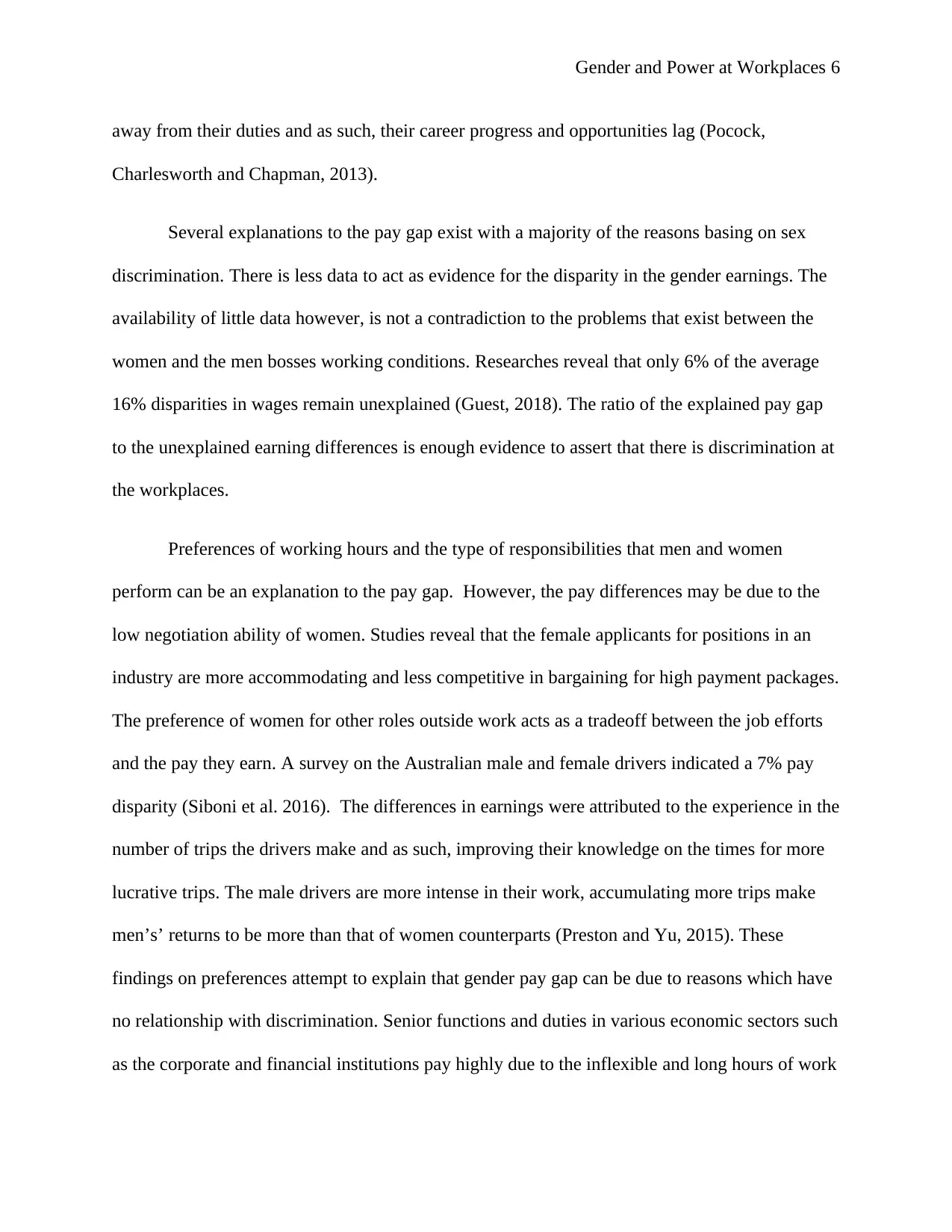
Gender and Power at Workplaces 6
away from their duties and as such, their career progress and opportunities lag (Pocock,
Charlesworth and Chapman, 2013).
Several explanations to the pay gap exist with a majority of the reasons basing on sex
discrimination. There is less data to act as evidence for the disparity in the gender earnings. The
availability of little data however, is not a contradiction to the problems that exist between the
women and the men bosses working conditions. Researches reveal that only 6% of the average
16% disparities in wages remain unexplained (Guest, 2018). The ratio of the explained pay gap
to the unexplained earning differences is enough evidence to assert that there is discrimination at
the workplaces.
Preferences of working hours and the type of responsibilities that men and women
perform can be an explanation to the pay gap. However, the pay differences may be due to the
low negotiation ability of women. Studies reveal that the female applicants for positions in an
industry are more accommodating and less competitive in bargaining for high payment packages.
The preference of women for other roles outside work acts as a tradeoff between the job efforts
and the pay they earn. A survey on the Australian male and female drivers indicated a 7% pay
disparity (Siboni et al. 2016). The differences in earnings were attributed to the experience in the
number of trips the drivers make and as such, improving their knowledge on the times for more
lucrative trips. The male drivers are more intense in their work, accumulating more trips make
men’s’ returns to be more than that of women counterparts (Preston and Yu, 2015). These
findings on preferences attempt to explain that gender pay gap can be due to reasons which have
no relationship with discrimination. Senior functions and duties in various economic sectors such
as the corporate and financial institutions pay highly due to the inflexible and long hours of work
away from their duties and as such, their career progress and opportunities lag (Pocock,
Charlesworth and Chapman, 2013).
Several explanations to the pay gap exist with a majority of the reasons basing on sex
discrimination. There is less data to act as evidence for the disparity in the gender earnings. The
availability of little data however, is not a contradiction to the problems that exist between the
women and the men bosses working conditions. Researches reveal that only 6% of the average
16% disparities in wages remain unexplained (Guest, 2018). The ratio of the explained pay gap
to the unexplained earning differences is enough evidence to assert that there is discrimination at
the workplaces.
Preferences of working hours and the type of responsibilities that men and women
perform can be an explanation to the pay gap. However, the pay differences may be due to the
low negotiation ability of women. Studies reveal that the female applicants for positions in an
industry are more accommodating and less competitive in bargaining for high payment packages.
The preference of women for other roles outside work acts as a tradeoff between the job efforts
and the pay they earn. A survey on the Australian male and female drivers indicated a 7% pay
disparity (Siboni et al. 2016). The differences in earnings were attributed to the experience in the
number of trips the drivers make and as such, improving their knowledge on the times for more
lucrative trips. The male drivers are more intense in their work, accumulating more trips make
men’s’ returns to be more than that of women counterparts (Preston and Yu, 2015). These
findings on preferences attempt to explain that gender pay gap can be due to reasons which have
no relationship with discrimination. Senior functions and duties in various economic sectors such
as the corporate and financial institutions pay highly due to the inflexible and long hours of work
⊘ This is a preview!⊘
Do you want full access?
Subscribe today to unlock all pages.

Trusted by 1+ million students worldwide
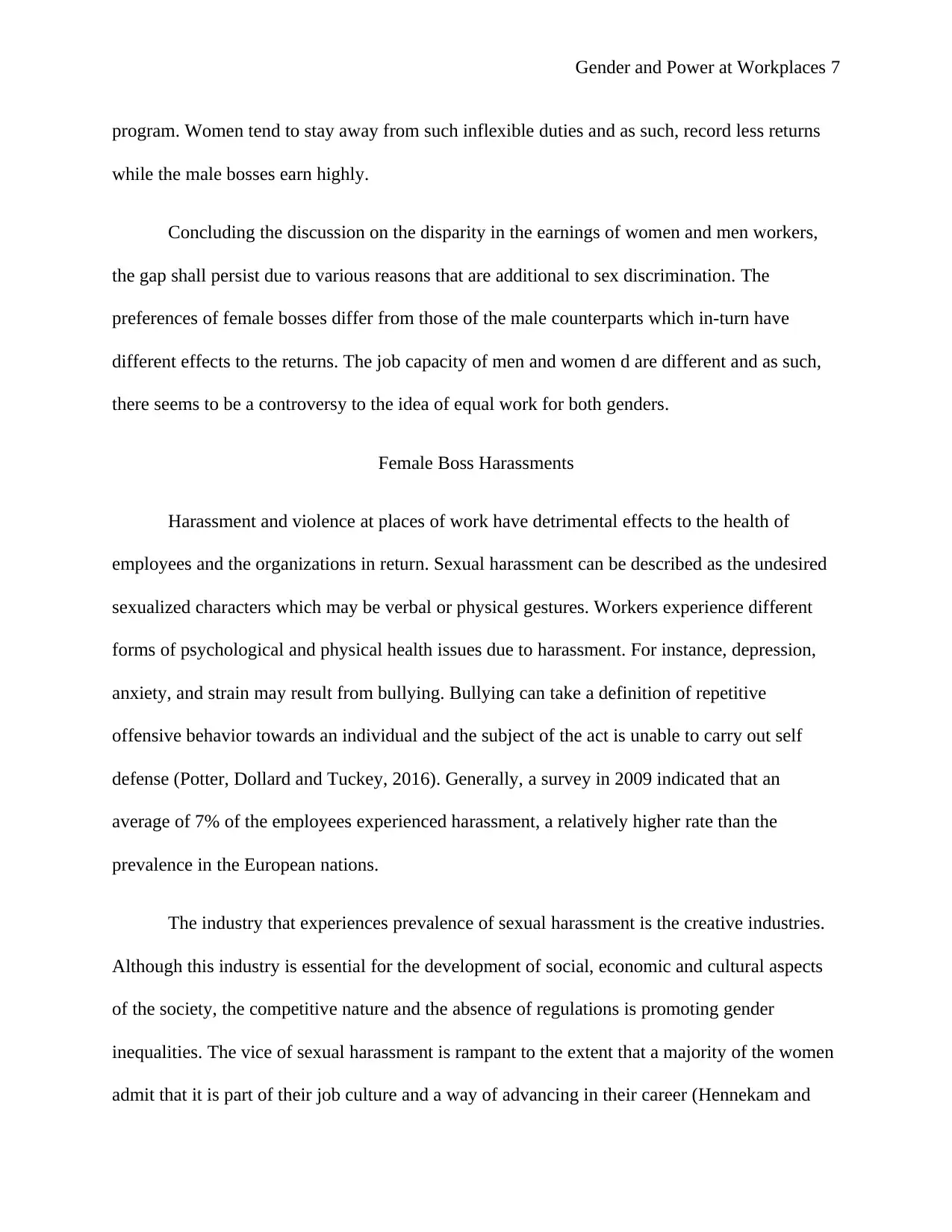
Gender and Power at Workplaces 7
program. Women tend to stay away from such inflexible duties and as such, record less returns
while the male bosses earn highly.
Concluding the discussion on the disparity in the earnings of women and men workers,
the gap shall persist due to various reasons that are additional to sex discrimination. The
preferences of female bosses differ from those of the male counterparts which in-turn have
different effects to the returns. The job capacity of men and women d are different and as such,
there seems to be a controversy to the idea of equal work for both genders.
Female Boss Harassments
Harassment and violence at places of work have detrimental effects to the health of
employees and the organizations in return. Sexual harassment can be described as the undesired
sexualized characters which may be verbal or physical gestures. Workers experience different
forms of psychological and physical health issues due to harassment. For instance, depression,
anxiety, and strain may result from bullying. Bullying can take a definition of repetitive
offensive behavior towards an individual and the subject of the act is unable to carry out self
defense (Potter, Dollard and Tuckey, 2016). Generally, a survey in 2009 indicated that an
average of 7% of the employees experienced harassment, a relatively higher rate than the
prevalence in the European nations.
The industry that experiences prevalence of sexual harassment is the creative industries.
Although this industry is essential for the development of social, economic and cultural aspects
of the society, the competitive nature and the absence of regulations is promoting gender
inequalities. The vice of sexual harassment is rampant to the extent that a majority of the women
admit that it is part of their job culture and a way of advancing in their career (Hennekam and
program. Women tend to stay away from such inflexible duties and as such, record less returns
while the male bosses earn highly.
Concluding the discussion on the disparity in the earnings of women and men workers,
the gap shall persist due to various reasons that are additional to sex discrimination. The
preferences of female bosses differ from those of the male counterparts which in-turn have
different effects to the returns. The job capacity of men and women d are different and as such,
there seems to be a controversy to the idea of equal work for both genders.
Female Boss Harassments
Harassment and violence at places of work have detrimental effects to the health of
employees and the organizations in return. Sexual harassment can be described as the undesired
sexualized characters which may be verbal or physical gestures. Workers experience different
forms of psychological and physical health issues due to harassment. For instance, depression,
anxiety, and strain may result from bullying. Bullying can take a definition of repetitive
offensive behavior towards an individual and the subject of the act is unable to carry out self
defense (Potter, Dollard and Tuckey, 2016). Generally, a survey in 2009 indicated that an
average of 7% of the employees experienced harassment, a relatively higher rate than the
prevalence in the European nations.
The industry that experiences prevalence of sexual harassment is the creative industries.
Although this industry is essential for the development of social, economic and cultural aspects
of the society, the competitive nature and the absence of regulations is promoting gender
inequalities. The vice of sexual harassment is rampant to the extent that a majority of the women
admit that it is part of their job culture and a way of advancing in their career (Hennekam and
Paraphrase This Document
Need a fresh take? Get an instant paraphrase of this document with our AI Paraphraser
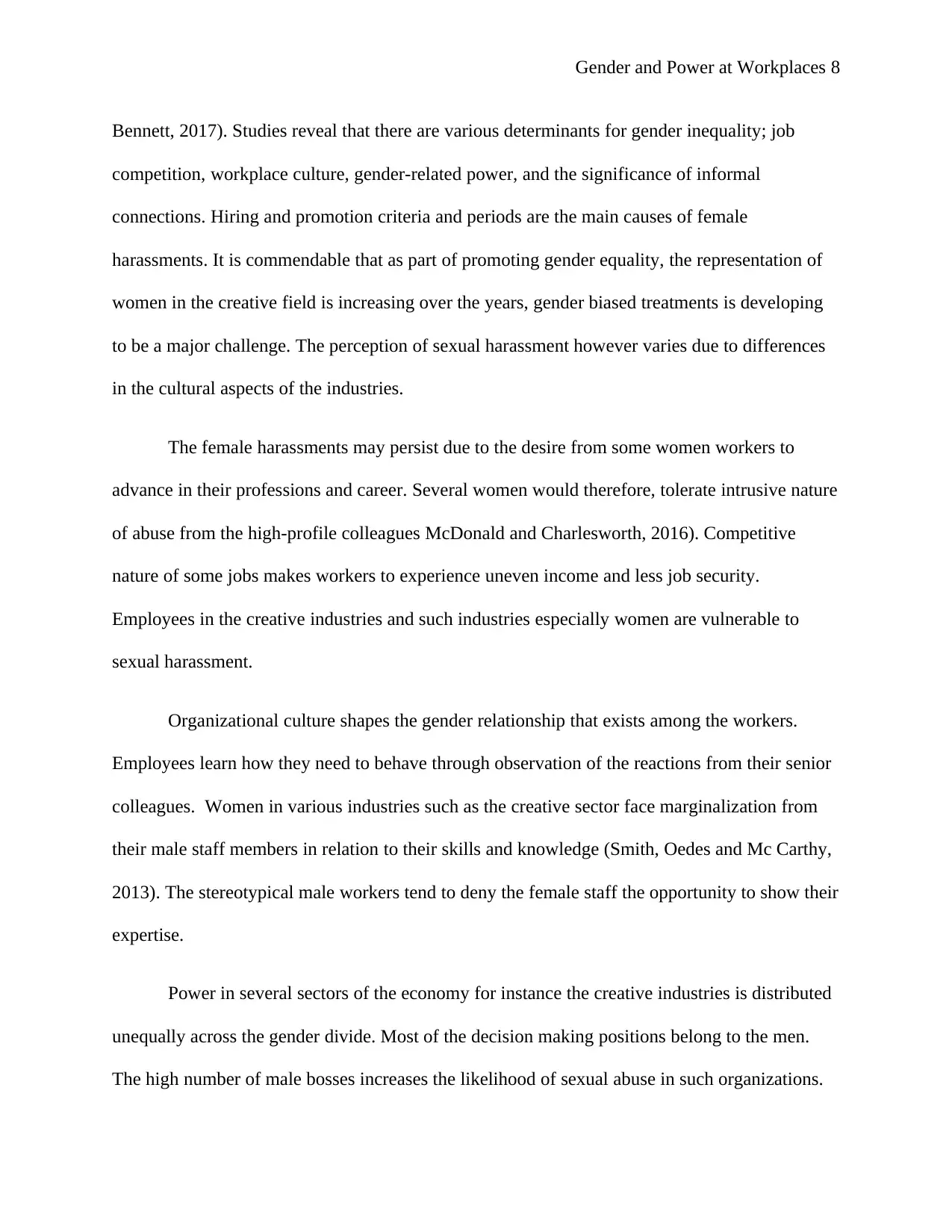
Gender and Power at Workplaces 8
Bennett, 2017). Studies reveal that there are various determinants for gender inequality; job
competition, workplace culture, gender-related power, and the significance of informal
connections. Hiring and promotion criteria and periods are the main causes of female
harassments. It is commendable that as part of promoting gender equality, the representation of
women in the creative field is increasing over the years, gender biased treatments is developing
to be a major challenge. The perception of sexual harassment however varies due to differences
in the cultural aspects of the industries.
The female harassments may persist due to the desire from some women workers to
advance in their professions and career. Several women would therefore, tolerate intrusive nature
of abuse from the high-profile colleagues McDonald and Charlesworth, 2016). Competitive
nature of some jobs makes workers to experience uneven income and less job security.
Employees in the creative industries and such industries especially women are vulnerable to
sexual harassment.
Organizational culture shapes the gender relationship that exists among the workers.
Employees learn how they need to behave through observation of the reactions from their senior
colleagues. Women in various industries such as the creative sector face marginalization from
their male staff members in relation to their skills and knowledge (Smith, Oedes and Mc Carthy,
2013). The stereotypical male workers tend to deny the female staff the opportunity to show their
expertise.
Power in several sectors of the economy for instance the creative industries is distributed
unequally across the gender divide. Most of the decision making positions belong to the men.
The high number of male bosses increases the likelihood of sexual abuse in such organizations.
Bennett, 2017). Studies reveal that there are various determinants for gender inequality; job
competition, workplace culture, gender-related power, and the significance of informal
connections. Hiring and promotion criteria and periods are the main causes of female
harassments. It is commendable that as part of promoting gender equality, the representation of
women in the creative field is increasing over the years, gender biased treatments is developing
to be a major challenge. The perception of sexual harassment however varies due to differences
in the cultural aspects of the industries.
The female harassments may persist due to the desire from some women workers to
advance in their professions and career. Several women would therefore, tolerate intrusive nature
of abuse from the high-profile colleagues McDonald and Charlesworth, 2016). Competitive
nature of some jobs makes workers to experience uneven income and less job security.
Employees in the creative industries and such industries especially women are vulnerable to
sexual harassment.
Organizational culture shapes the gender relationship that exists among the workers.
Employees learn how they need to behave through observation of the reactions from their senior
colleagues. Women in various industries such as the creative sector face marginalization from
their male staff members in relation to their skills and knowledge (Smith, Oedes and Mc Carthy,
2013). The stereotypical male workers tend to deny the female staff the opportunity to show their
expertise.
Power in several sectors of the economy for instance the creative industries is distributed
unequally across the gender divide. Most of the decision making positions belong to the men.
The high number of male bosses increases the likelihood of sexual abuse in such organizations.
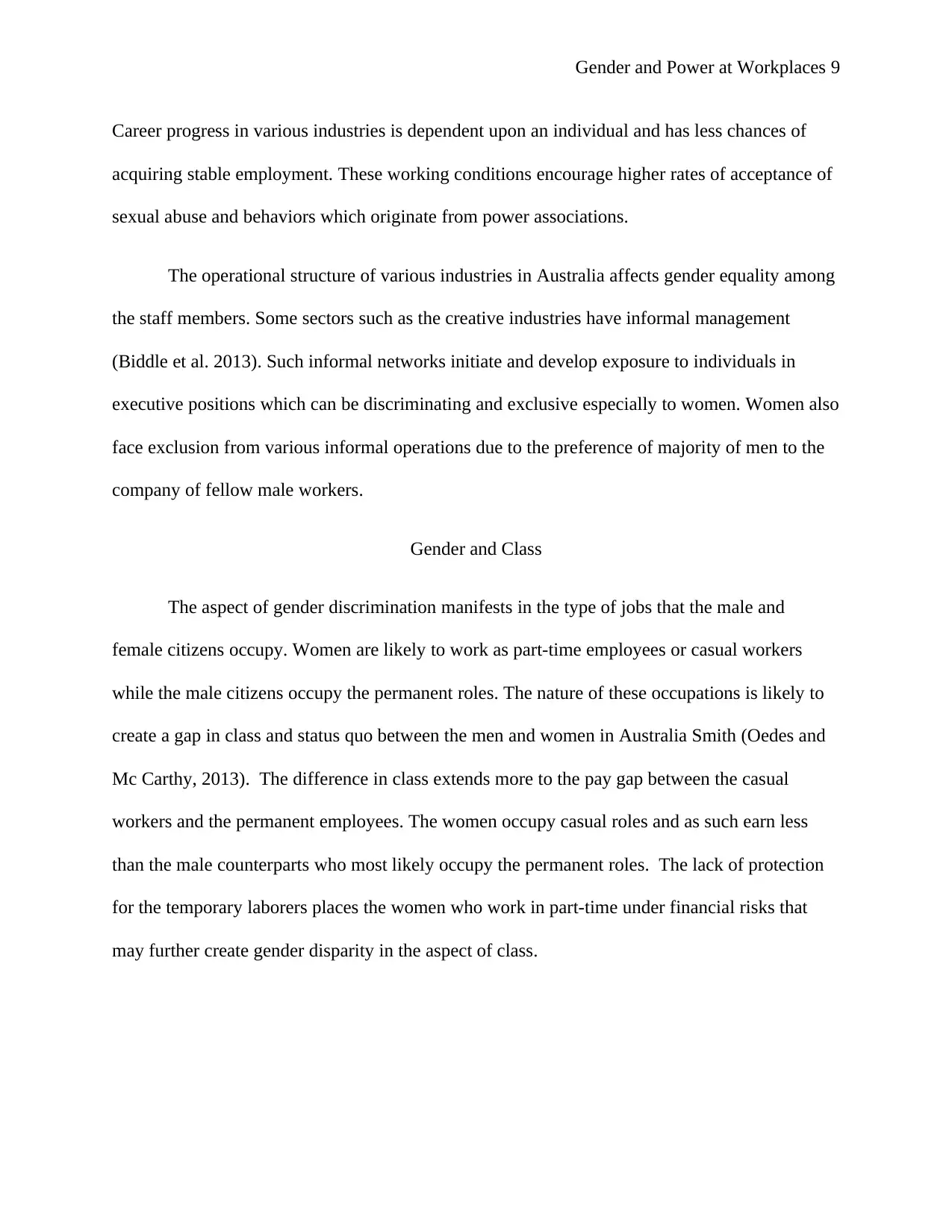
Gender and Power at Workplaces 9
Career progress in various industries is dependent upon an individual and has less chances of
acquiring stable employment. These working conditions encourage higher rates of acceptance of
sexual abuse and behaviors which originate from power associations.
The operational structure of various industries in Australia affects gender equality among
the staff members. Some sectors such as the creative industries have informal management
(Biddle et al. 2013). Such informal networks initiate and develop exposure to individuals in
executive positions which can be discriminating and exclusive especially to women. Women also
face exclusion from various informal operations due to the preference of majority of men to the
company of fellow male workers.
Gender and Class
The aspect of gender discrimination manifests in the type of jobs that the male and
female citizens occupy. Women are likely to work as part-time employees or casual workers
while the male citizens occupy the permanent roles. The nature of these occupations is likely to
create a gap in class and status quo between the men and women in Australia Smith (Oedes and
Mc Carthy, 2013). The difference in class extends more to the pay gap between the casual
workers and the permanent employees. The women occupy casual roles and as such earn less
than the male counterparts who most likely occupy the permanent roles. The lack of protection
for the temporary laborers places the women who work in part-time under financial risks that
may further create gender disparity in the aspect of class.
Career progress in various industries is dependent upon an individual and has less chances of
acquiring stable employment. These working conditions encourage higher rates of acceptance of
sexual abuse and behaviors which originate from power associations.
The operational structure of various industries in Australia affects gender equality among
the staff members. Some sectors such as the creative industries have informal management
(Biddle et al. 2013). Such informal networks initiate and develop exposure to individuals in
executive positions which can be discriminating and exclusive especially to women. Women also
face exclusion from various informal operations due to the preference of majority of men to the
company of fellow male workers.
Gender and Class
The aspect of gender discrimination manifests in the type of jobs that the male and
female citizens occupy. Women are likely to work as part-time employees or casual workers
while the male citizens occupy the permanent roles. The nature of these occupations is likely to
create a gap in class and status quo between the men and women in Australia Smith (Oedes and
Mc Carthy, 2013). The difference in class extends more to the pay gap between the casual
workers and the permanent employees. The women occupy casual roles and as such earn less
than the male counterparts who most likely occupy the permanent roles. The lack of protection
for the temporary laborers places the women who work in part-time under financial risks that
may further create gender disparity in the aspect of class.
⊘ This is a preview!⊘
Do you want full access?
Subscribe today to unlock all pages.

Trusted by 1+ million students worldwide
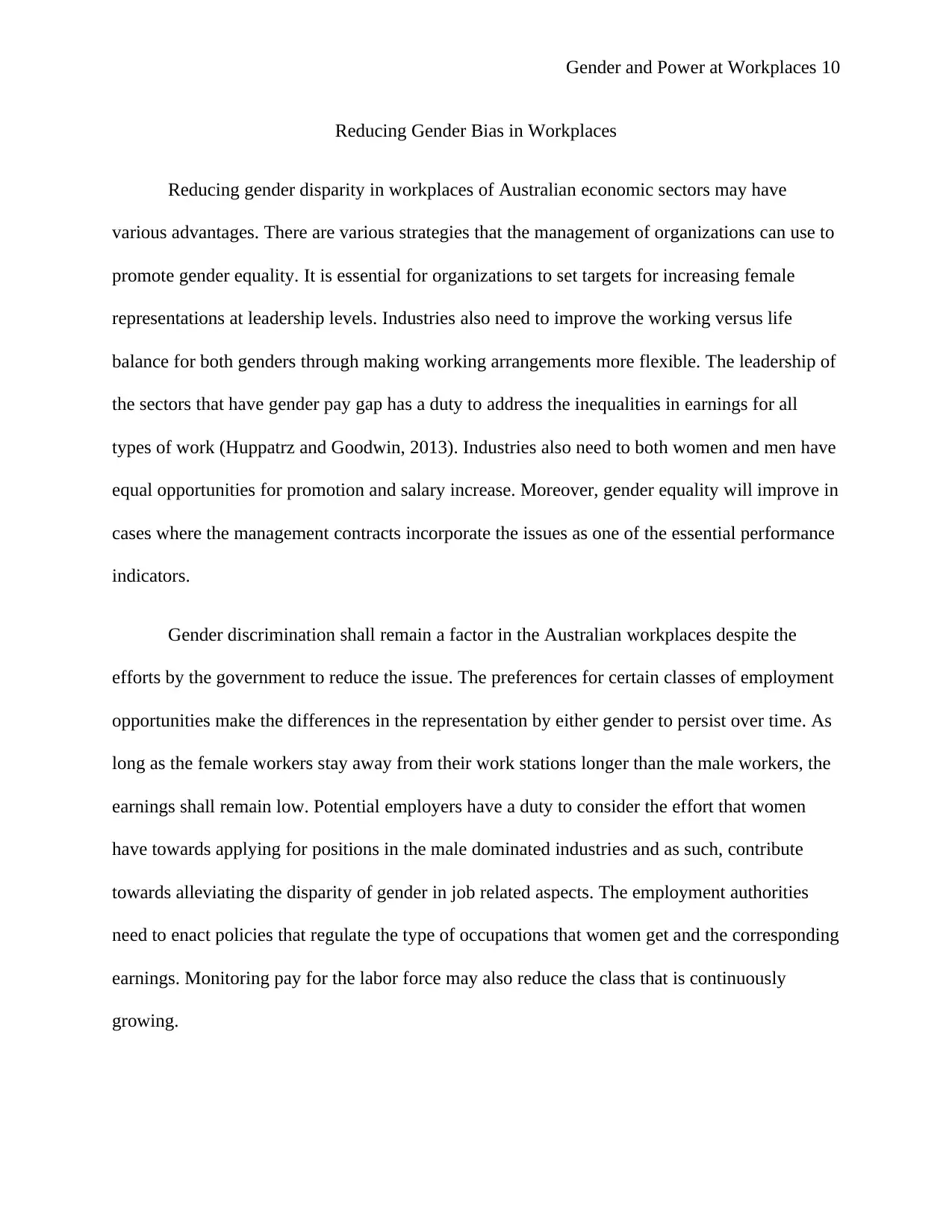
Gender and Power at Workplaces 10
Reducing Gender Bias in Workplaces
Reducing gender disparity in workplaces of Australian economic sectors may have
various advantages. There are various strategies that the management of organizations can use to
promote gender equality. It is essential for organizations to set targets for increasing female
representations at leadership levels. Industries also need to improve the working versus life
balance for both genders through making working arrangements more flexible. The leadership of
the sectors that have gender pay gap has a duty to address the inequalities in earnings for all
types of work (Huppatrz and Goodwin, 2013). Industries also need to both women and men have
equal opportunities for promotion and salary increase. Moreover, gender equality will improve in
cases where the management contracts incorporate the issues as one of the essential performance
indicators.
Gender discrimination shall remain a factor in the Australian workplaces despite the
efforts by the government to reduce the issue. The preferences for certain classes of employment
opportunities make the differences in the representation by either gender to persist over time. As
long as the female workers stay away from their work stations longer than the male workers, the
earnings shall remain low. Potential employers have a duty to consider the effort that women
have towards applying for positions in the male dominated industries and as such, contribute
towards alleviating the disparity of gender in job related aspects. The employment authorities
need to enact policies that regulate the type of occupations that women get and the corresponding
earnings. Monitoring pay for the labor force may also reduce the class that is continuously
growing.
Reducing Gender Bias in Workplaces
Reducing gender disparity in workplaces of Australian economic sectors may have
various advantages. There are various strategies that the management of organizations can use to
promote gender equality. It is essential for organizations to set targets for increasing female
representations at leadership levels. Industries also need to improve the working versus life
balance for both genders through making working arrangements more flexible. The leadership of
the sectors that have gender pay gap has a duty to address the inequalities in earnings for all
types of work (Huppatrz and Goodwin, 2013). Industries also need to both women and men have
equal opportunities for promotion and salary increase. Moreover, gender equality will improve in
cases where the management contracts incorporate the issues as one of the essential performance
indicators.
Gender discrimination shall remain a factor in the Australian workplaces despite the
efforts by the government to reduce the issue. The preferences for certain classes of employment
opportunities make the differences in the representation by either gender to persist over time. As
long as the female workers stay away from their work stations longer than the male workers, the
earnings shall remain low. Potential employers have a duty to consider the effort that women
have towards applying for positions in the male dominated industries and as such, contribute
towards alleviating the disparity of gender in job related aspects. The employment authorities
need to enact policies that regulate the type of occupations that women get and the corresponding
earnings. Monitoring pay for the labor force may also reduce the class that is continuously
growing.
Paraphrase This Document
Need a fresh take? Get an instant paraphrase of this document with our AI Paraphraser

Gender and Power at Workplaces 11
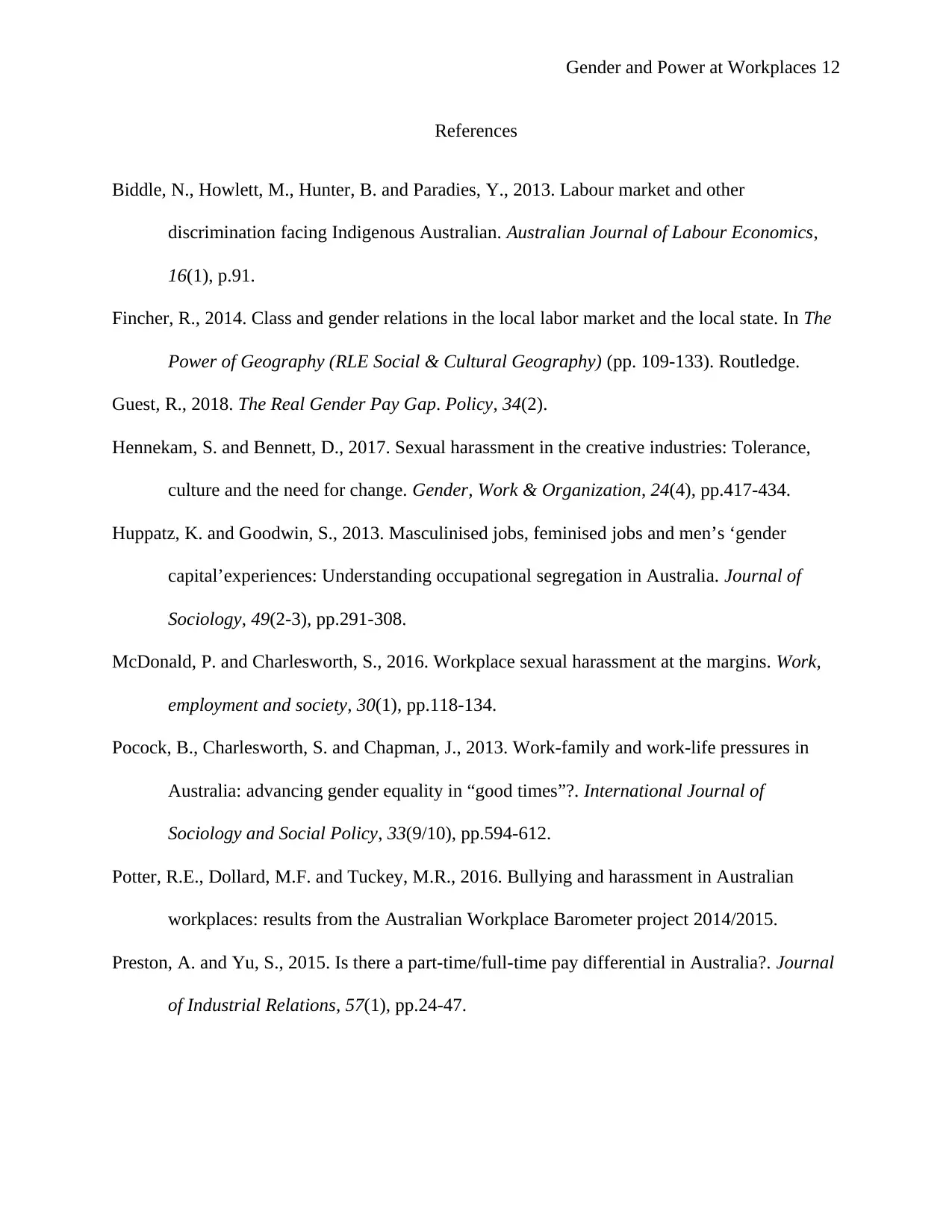
Gender and Power at Workplaces 12
References
Biddle, N., Howlett, M., Hunter, B. and Paradies, Y., 2013. Labour market and other
discrimination facing Indigenous Australian. Australian Journal of Labour Economics,
16(1), p.91.
Fincher, R., 2014. Class and gender relations in the local labor market and the local state. In The
Power of Geography (RLE Social & Cultural Geography) (pp. 109-133). Routledge.
Guest, R., 2018. The Real Gender Pay Gap. Policy, 34(2).
Hennekam, S. and Bennett, D., 2017. Sexual harassment in the creative industries: Tolerance,
culture and the need for change. Gender, Work & Organization, 24(4), pp.417-434.
Huppatz, K. and Goodwin, S., 2013. Masculinised jobs, feminised jobs and men’s ‘gender
capital’experiences: Understanding occupational segregation in Australia. Journal of
Sociology, 49(2-3), pp.291-308.
McDonald, P. and Charlesworth, S., 2016. Workplace sexual harassment at the margins. Work,
employment and society, 30(1), pp.118-134.
Pocock, B., Charlesworth, S. and Chapman, J., 2013. Work-family and work-life pressures in
Australia: advancing gender equality in “good times”?. International Journal of
Sociology and Social Policy, 33(9/10), pp.594-612.
Potter, R.E., Dollard, M.F. and Tuckey, M.R., 2016. Bullying and harassment in Australian
workplaces: results from the Australian Workplace Barometer project 2014/2015.
Preston, A. and Yu, S., 2015. Is there a part-time/full-time pay differential in Australia?. Journal
of Industrial Relations, 57(1), pp.24-47.
References
Biddle, N., Howlett, M., Hunter, B. and Paradies, Y., 2013. Labour market and other
discrimination facing Indigenous Australian. Australian Journal of Labour Economics,
16(1), p.91.
Fincher, R., 2014. Class and gender relations in the local labor market and the local state. In The
Power of Geography (RLE Social & Cultural Geography) (pp. 109-133). Routledge.
Guest, R., 2018. The Real Gender Pay Gap. Policy, 34(2).
Hennekam, S. and Bennett, D., 2017. Sexual harassment in the creative industries: Tolerance,
culture and the need for change. Gender, Work & Organization, 24(4), pp.417-434.
Huppatz, K. and Goodwin, S., 2013. Masculinised jobs, feminised jobs and men’s ‘gender
capital’experiences: Understanding occupational segregation in Australia. Journal of
Sociology, 49(2-3), pp.291-308.
McDonald, P. and Charlesworth, S., 2016. Workplace sexual harassment at the margins. Work,
employment and society, 30(1), pp.118-134.
Pocock, B., Charlesworth, S. and Chapman, J., 2013. Work-family and work-life pressures in
Australia: advancing gender equality in “good times”?. International Journal of
Sociology and Social Policy, 33(9/10), pp.594-612.
Potter, R.E., Dollard, M.F. and Tuckey, M.R., 2016. Bullying and harassment in Australian
workplaces: results from the Australian Workplace Barometer project 2014/2015.
Preston, A. and Yu, S., 2015. Is there a part-time/full-time pay differential in Australia?. Journal
of Industrial Relations, 57(1), pp.24-47.
⊘ This is a preview!⊘
Do you want full access?
Subscribe today to unlock all pages.

Trusted by 1+ million students worldwide
1 out of 13
Related Documents
Your All-in-One AI-Powered Toolkit for Academic Success.
+13062052269
info@desklib.com
Available 24*7 on WhatsApp / Email
![[object Object]](/_next/static/media/star-bottom.7253800d.svg)
Unlock your academic potential
Copyright © 2020–2025 A2Z Services. All Rights Reserved. Developed and managed by ZUCOL.





